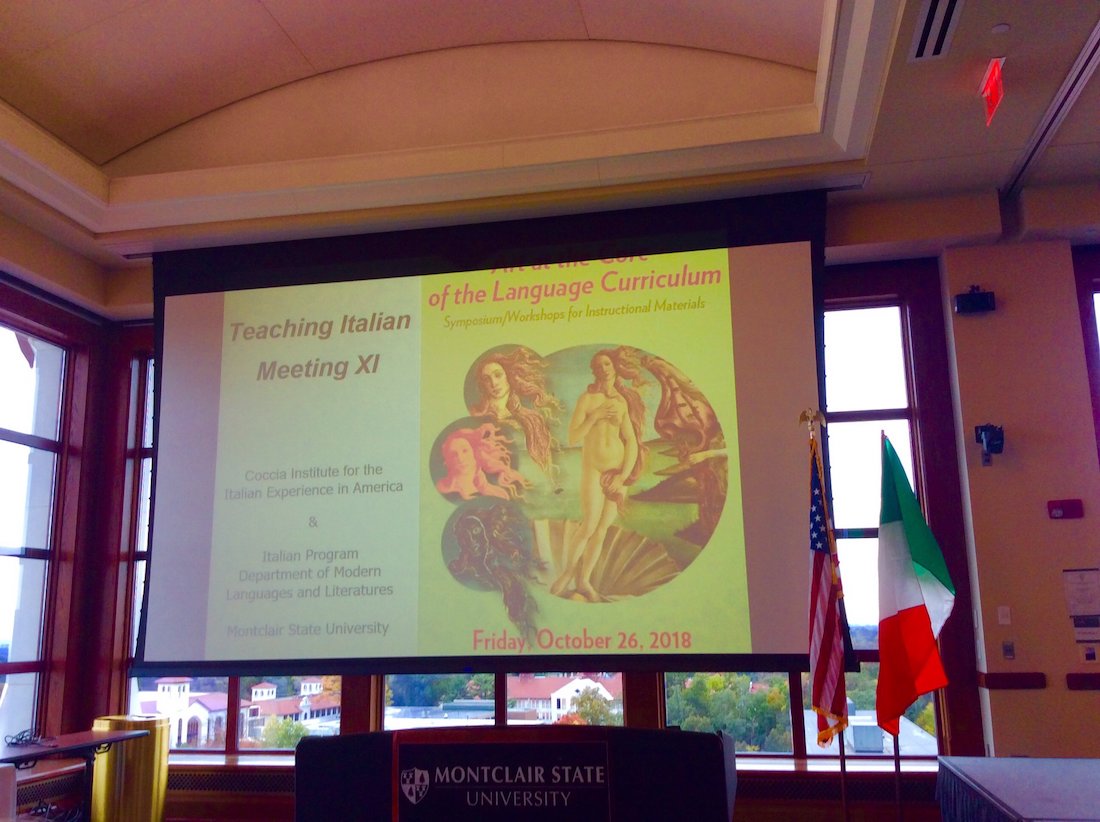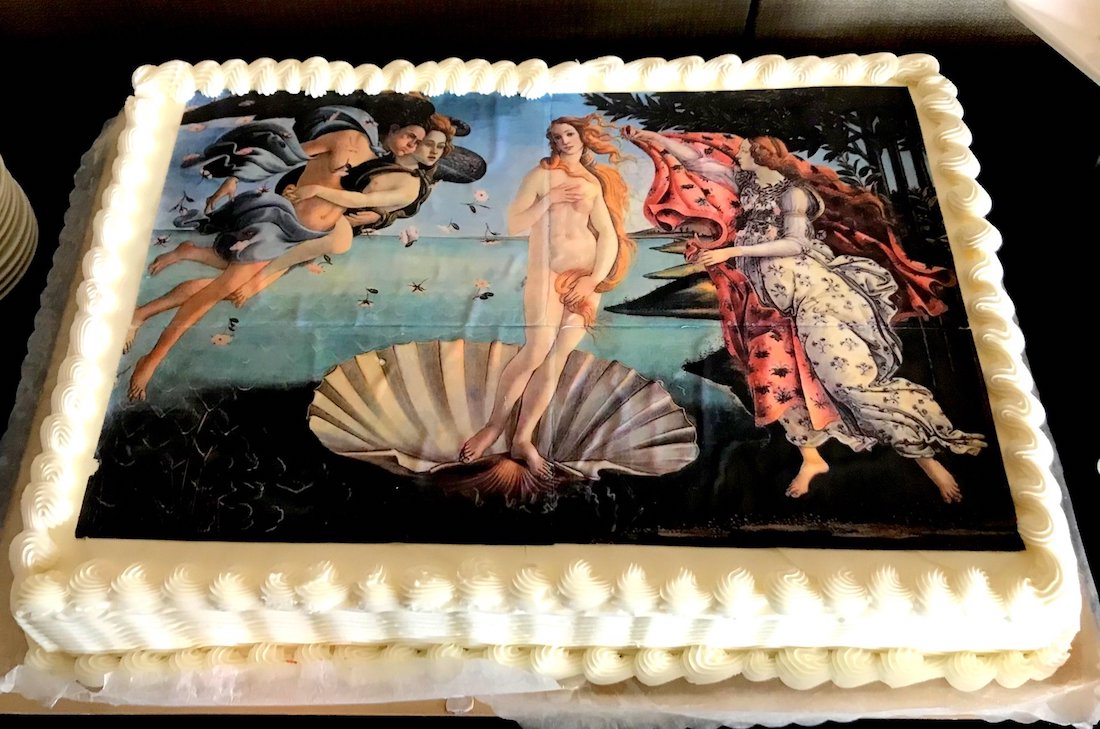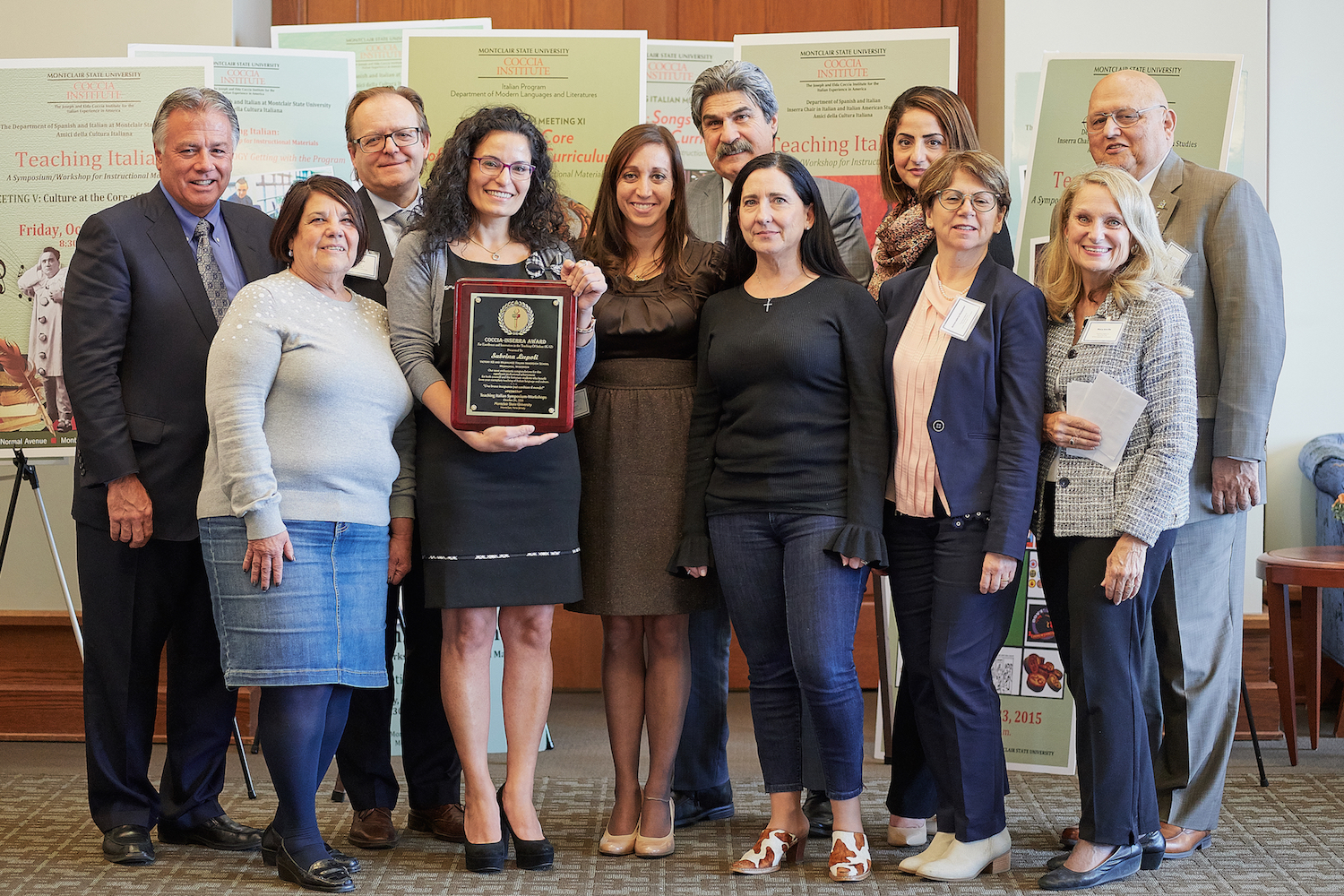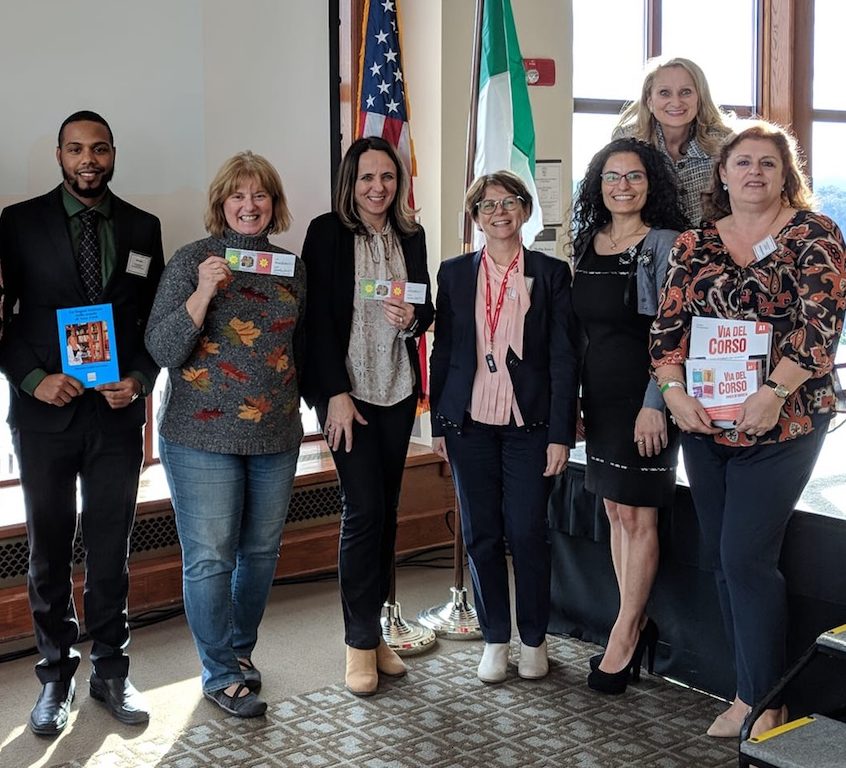At Montclair State University on Friday, October 26th, the eleventh Teaching Italian Symposium/Workshops, “Art at the Core of the Language Curriculum,” was dedicated to the enhancement of the teaching of the Italian language in North America. The day was beautiful, and from the windows of the conference center, which is situated on the seventh floor of University Hall, one could admire not only the panoramic view of the university, but also the Manhattan skyline.
The symposium is organized every year by Professor Enza Antenos, Italian Teacher Education Coordinator at Montclair State, and Dr. Mary Ann Re, Director of the Coccia Institute for the Italian Experience in America. After a welcome from Dr. Re, Dean Robert Friedman of the College of Humanities and Social Sciences kicked-off the progam. Dr. Friedman praised the Italian program at Montclair State, singling out in particular Prof. Antenos for her leadership role in the creation of a new undergraduate degree (BA) in Language, Business & Culture. Antenos also serves as student advisor of Italian for this degree and the traditional major.

Antenos stated that every year at the symposium, a unique signature event for the Italian language in the U.S., teachers come from every part of the United States, from Italy, and sometimes even from Canada. The data provided show that the majority of participants are high school Italian teachers; an objective of the Italian program at Montclair is to attract more elementary and middle school-level Italian teachers to the symposium. Antenos highlighted that only by increasing the number of students in lower levels of Italian can there be an increase in enrollment in advanced Italian courses at universities. “Although the study of Italian in public schools and AP Italian courses has grown—said Antenos—universities, instead, are going through a difficult phase because the number of students in Italian courses has not increased, and so this decrease in enrollments translates to lower enrollments in advanced Italian courses, a problem plaguing universities nationwide.”
 Prof. Antenos introduced Dr. Annavaleria Guazzieri, Director of the Office of Education for the Consulate General of Italy in New York, who provided the keynote address entitled “Building Bridges Between Art and Language.” The symposium then featured a panel discussion of workshop presenters and a question and answer session driven by participants. They exchanged ideas on ways to make the teaching of the Italian language more creative and engaging by creating bridges between the arts and the study of the foreign language. During the panel discussion, it was evident that the instruction of languages must take into consideration every type of activity to help students continue their studies of the foreign language with enthusiasm and motivation. According to Dr. Guazzieri, “Art is fundamental for human life, just as language is, and through artistic concepts, linguistic activities, reflections, exchanges of opinions, and ideas, bridges between the two disciplines can be created. Art can also be taught without prerequisites or help from art teachers. In Italian classes, art can be a very important tool to motivate students, and teachers do not have to be artists or art critics to be able to promote creativity, fun, and a profound linguistic instruction. However, one should keep in mind that incorporating art into the language curriculum does not just mean teaching art at advanced levels using traditional methods, but using it as an pedagogical strategy even in beginner courses, through collaboration with art experts, colleagues in the artistic field, and interaction with museum institutions and foundations.”
Prof. Antenos introduced Dr. Annavaleria Guazzieri, Director of the Office of Education for the Consulate General of Italy in New York, who provided the keynote address entitled “Building Bridges Between Art and Language.” The symposium then featured a panel discussion of workshop presenters and a question and answer session driven by participants. They exchanged ideas on ways to make the teaching of the Italian language more creative and engaging by creating bridges between the arts and the study of the foreign language. During the panel discussion, it was evident that the instruction of languages must take into consideration every type of activity to help students continue their studies of the foreign language with enthusiasm and motivation. According to Dr. Guazzieri, “Art is fundamental for human life, just as language is, and through artistic concepts, linguistic activities, reflections, exchanges of opinions, and ideas, bridges between the two disciplines can be created. Art can also be taught without prerequisites or help from art teachers. In Italian classes, art can be a very important tool to motivate students, and teachers do not have to be artists or art critics to be able to promote creativity, fun, and a profound linguistic instruction. However, one should keep in mind that incorporating art into the language curriculum does not just mean teaching art at advanced levels using traditional methods, but using it as an pedagogical strategy even in beginner courses, through collaboration with art experts, colleagues in the artistic field, and interaction with museum institutions and foundations.”
The first session of four concurrent hands-on workshops ensued, with seminars by Annavaleria Guazzieri, Director of the Office of Education for the Consulate General of Italy in New York, with the workshop “BICS and CALP and How Art Can Help Develop More Complex Language Skills”; Matteo Broggini, of the Center of Language and Italian Culture for Foreigners (Milan), who presented “AttivItalia”; a workshop co-presented by Matilde Fogliani from the Graduate Center (CUNY) and Luisanna Sardu from Manhattan College on “Italian Art through Advertisement”; and Gina Gallo from Bristol Central High School (CT) who presented “Using Art as the Pallet for World Language Instruction.”

The workshops described the importance of bringing language students to visit museums and art exhibits, and in class, to not miss out on a virtual tour of one of the 53 Italian UNESCO sites. UNESCO sites are of extraordinary beauty and feature entire cities such as Florence, Rome, Naples, and Palermo, but there are also protected places and natural landscapes such as the Dolomites, Venice and its lagoon, the Aeolian Islands, and many others. Furthermore, art is also closely connected to the ability to express emotions and subjective messages, and through a selection of materials related to what students like most, lessons can be created to stimulate enthusiasm in the classroom. Therefore, learning adjectives and the verb “piacere” (to like) can become very interactive and fun for the students, because they will be stimulated to express what they feel during the lesson and what they like and dislike.
I attended Dr. Annavaleria Guazzieri’s workshop, “BICS and CALP and How to Develop More Complex Language Skills” on the CLIL principle, a learning method that puts students at the center, integrates language and content, and at the same time, poses a cognitive challenge to students. CLIL (Content and Language Integrated Learning) is an operational model that responds to the interests and attitudes of different students and is applicable to many age groups and different contexts, so it can be used in both elementary and higher-education classes. In short, it is a methodology that opens the doors to other disciplines for language teaching. “We can talk about art endlessly,” said Guazzieri. “Art, in its broadest meaning, includes every human activity, like arte povera or professions of time-honored traditions.”
Reflecting on the words of Guazzieri, I quote the ten principal forms of art from which all the others, called minor arts, are connected: painting, including drawing, engraving, and digital graphics; sculpture, including jewelry-making, textile art, tapestry and origami; architecture, literature, music, dance, theater, cinema and video art, photography, and comics, as well as cooking and baking. As you may have noticed, the list is also a long list of terms for students to learn. Dr. Guazzieri argues that artistic activities also offer opportunities to interact with the target linguistic culture without being ethnocentric: you can also use non-Italian art and demonstrate the appreciation of both Italian and foreign art in the classroom. Plus, New York City hosts extraordinary collections of Italian art, so the teachers who teach in NYC can easily build bridges between art and language. New Jersey also offers beautiful museums and art collections of the highest level, including at Montclair State.

However, in my opinion, art is not just a famous painting, a statue, or a masterpiece, but it can also be a simple branch of a tree bent in a certain way that reflects the opinions and emotions of the artist in the social, moral, cultural, ethical or religious environment, and/or of the historical period in which he/she lives or has lived. Even Italian food and cuisine are works of art, and at the symposium we could see it through admiring the splendid cake with the image of Botticelli’s The Birth of Venus. And so, we could talk about art endlessly and art can become an excellent means of learning for every level of Italian, because students can also learn basic vocabulary through arte povera. Art can also be subjective both for those who create it and for those who admire it, and the simplest example of this can be songs; a song for one student can be artistic and can arouse emotions and memories, while for another, a song may have no impact, the student remains indifferent. And for this reason, even grammar can be learned in an informal and creative way, putting art, its beauty, and the emotions that are evoked not only at the center of Italian culture and life, but also at that of the students’.

During the lunch hour, the “Coccia-Inserra Award for Excellence and Innovation in the Teaching of Italian (K-12)” was presented. The $5000 prize, half of which is to be used for the professional development of the teacher, and half to promote Italian in the teacher’s school with materials and/or cultural field trips for students, is the result of the generosity of two benefactors: Lawrence (Larry) Inserra, Jr. (CEO, Inserra Supermarkets) and the Coccia Foundation (of which the Coccia Institute is the academic branch), represented by two Coccia Foundation Trustees: Joseph Agresti (Past President of UNICO National) and Diana Zoino, teacher of Italian at Cresskill High School, NJ). This year the winner of the award was Sabrina Lupoli, a Wisconsin elementary school Italian teacher at Victory K-8 and Milwaukee Italian Immersion School. To be considered for the award, Italian teachers must be a U.S. resident and a member of ITANJ (Italian Teachers of New Jersey), or AATI (American Association of Teachers of Italian). The Honorary Consul of New Jersey, Dominic Caruso, a graduate in political science from Montclair State, attended the award ceremony and congratulated the recipient.

The symposium concluded with a raffle in which four prizes were drawn: two prizes of $250 each, provided by an anonymous donor, to develop a lesson or fund a field trip on the theme of art; a book for teachers donated by the writer of these lines; and a manual and board game for students. In addition, Dr. Guazzieri bestowed to Elisaul Valdez, a teacher of Italian at J.P. Stevens High School, the EDUITALIA award, organized and managed by the Consulate General, which consists of two weeks of study in Italy. Elisaul Valdez, a Montclair State alumnus and former student of Prof. Antenos, was also the winner of a copy of my book, “La lingua italiana a New York.”
I end my reflection on the symposium with a quote from Terzani: “Art comforts us, lifts us, art directs us. Art takes care of us. We are not just what we eat and the air we breathe. We are also the stories we have heard, the tales we have fallen asleep to as children, the books we have read, the music we have listened to and the emotions that a picture, a statue, a poem have given us.” –Tiziano Terzani “Un altro giro di giostra” (One More Ride on the Merry-Go-Round)
To the teachers of Italian, I recommend the following link, where they can find lessons on teaching Italian including art: Italian with art history: 32 exercises and comprehension assignments for foreign students.
Translated by Christina Pari












